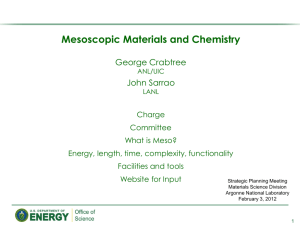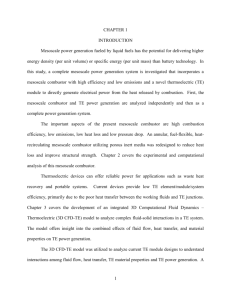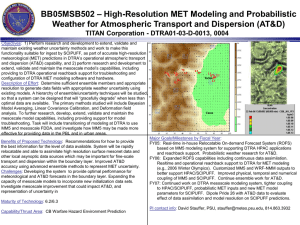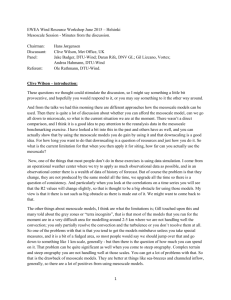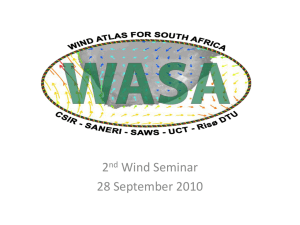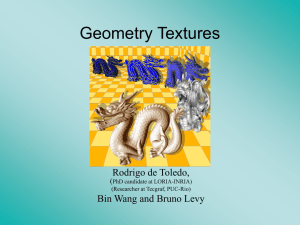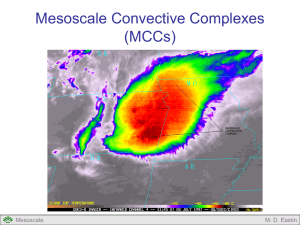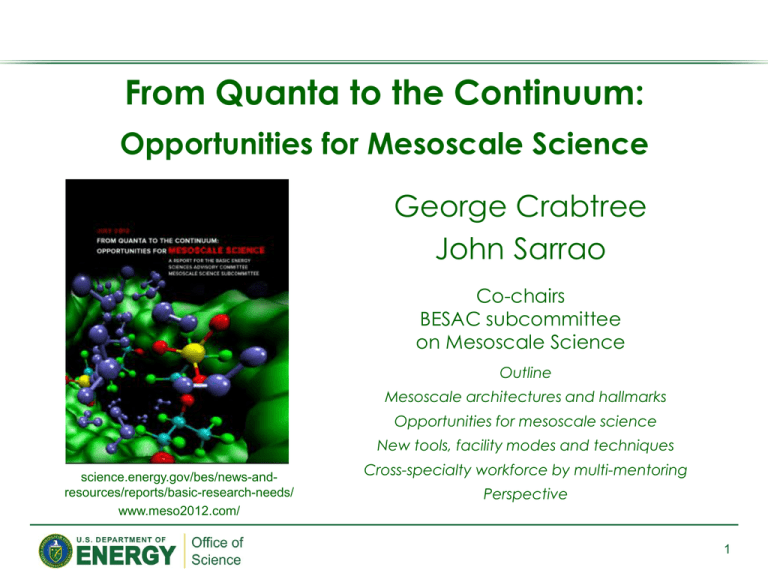
From Quanta to the Continuum:
Opportunities for Mesoscale Science
George Crabtree
John Sarrao
Co-chairs
BESAC subcommittee
on Mesoscale Science
Outline
Mesoscale architectures and hallmarks
Opportunities for mesoscale science
New tools, facility modes and techniques
science.energy.gov/bes/news-andresources/reports/basic-research-needs/
www.meso2012.com/
Cross-specialty workforce by multi-mentoring
Perspective
1
The BESAC Charge on Mesoscale Science
Excerpts from Dr. Brinkman’s charge letter of February 14, 2011:
A central theme of these reports is the importance of atomic and molecular scale
understanding of how nature works and how this relates to advancing the frontiers of
science and innovation. I would now like BESAC to extend this work by addressing
the research agenda for mesoscale science, the regime where classical, microscale
science and nanoscale science meet. I see two parts to this new study:
1. Identify mesoscale science directions that are most promising for advancing
the Department’s energy mission.
2. Identify how current and future BES facilities can impact mesoscale science.
This study could prompt a national discussion of mesoscale science at the level
heard during the initial formulation of the National Nanotechnology Initiative a decade
ago.
Report due early Fall 2012
2
The BESAC Meso Subcommittee
John Sarrao, LANL, co-chair
George Crabtree, ANL & UIC, BESAC, co-chair
John Hemminger, Irvine, BESAC chair
William Barletta, MIT, BESAC
Gordon Brown, Stanford, BESAC
Roger French, CWRU, BESAC
Laura Greene, UIUC, BESAC
Bruce Kay, PNNL, BESAC
Mark Ratner, Northwestern, BESAC
John Spence, Arizona, BESAC
Doug Tobias, Irvine, BESAC
John Tranquada, Brookhaven, BESAC
Paul Alivisatos, LBNL
Frank Bates, Minnesota
Marc Kastner, MIT
Jennifer Lewis, UIUC
Tony Rollett, CMU
Gary Rubloff, Maryland
3
Mesoscale Architectures
dynamics
structure
50 nm
Polymer
science
properties
Supramolecular
chemistry
nanocrystal
arrays
20 nm
multilayers
100 µm
phase separation
fossil fuels
CH4
methane
teflon
polarization
domains
CF4 carbon
tetrafluoride
chemical
bonds
periodic
lattices
atoms
4
Hallmarks of Mesoscale Phenomena
Diminished atomic granularity
The position and presence
of a given atom
has decreasing impact
Degree of energy quantization
a
n=3
E
E=
n=2
n=1
a
n2 h2
8ma 2
ΔE = 3h2/8ma2
0.1 nm
106 K
1 nm
104 K
10 nm
102 K
100 nm
1 K
1000 nm
0.01 K
room temperature
Increasing length scale promotes interactions
with environment, greater complexity, new phenomena
5
Hallmarks of Mesoscale Phenomena
Developed collective behavior
Interacting degrees of freedom
e.g., charge screening
0.4
Length:34µm
2.8 V
Height (µm)
0.2
0.0
-0.2
-0.4
-0.6
-0.8
charge compensation
length
metals
semiconductors
electrons
electrons / holes
Thomas-Fermi
0.1 nm
Debye
1-1000 nm
electrolytes
ions
Debye-Huckel
0.1 – 100 nm
Cantilever
clamping
point
0
0.02
Length (mm)
0V
0.04
Baek et al,
Science 334, 958 (2011)
piezoelectricity
electrons+phonons=superconductivity
ferromagnetism+ferroelectricity=multiferroics
photon+semiconductor=electron
...
6
Hallmarks of Mesoscale Phenomena
Defects, fluctuations,
statistical variation
Heterogeneity in
structure and dynamics
nanoparticles: single grain, single domain
small molecules
perfect structure
large assemblies
imperfect structure
basis for genetic mutation
and evolution
In mesoscale and larger crystals
defects profoundly affect
• electrical conductivity
• mechanical response
• heat transport
meso and larger particles
heterogeneous grain and domain structures
composite parts that cooperate
degrees of freedom interact across interface
7
Examples of Mesoscale Phenomena
Giant Magnetoresistance
Hallmarks
• Heterogeneity
CoFe
• Interacting degrees of
freedom
MgO
charge and spin
CoFe
OK
• Defects at surface
Birth of spintronics
Permanently changed the landscape of computer memory
Photo-electro-chemical Water Splitting
• interacting degrees of freedom
photonic, electronic, chemical
• heterogeneous - composite parts
O2
H2O
H+
• defects, fluctuations, statistical variation
• atoms and quantized energies
• continuous matter and energy
H2O
H2
8
diffractiveX-ray opticsaslenses, and form
imagesthrough theabsorption of X-raysby
theconstituent materialsof thesample. On
page436of thisissue, Dierolf et al.1 neatlysidestep both of theserequirements: they obtain
quantitative, three-dimensional imagesof a
thick bonesamplewithout theuseof optics,
whiledeliveringalessdamagingdoseof X-rays
to the sample.
X-ray microscopy hasfound wideapplication in theimaging of cells, coal and fossils,
interplanetary dust, magneticmaterials, polymers, catalysts and many other biological and
technologically relevant materials2. Thekey
technology for high-resolution X-ray microscopy is the zone plate. This device bends
X-raysby diffraction —rather than refraction —to makealens. Instead of thecareful
polishingof glass, agood zoneplaterequires
linestructurestobefabricated at precisionsof
tensof nanometres. In fact, thehighest resolution of thelensisgiven directlybythesmallest
‘linewidth’, or featuresize, that can befabricated. A good optical microscopecan resolve
featurescomparablein sizeto thewavelength
of light used to illuminatethesample. However, by thismeasure, theresolution obtained
byzoneplatesismorethan ten timesworse, so
there is plenty of room for improvement.
A new disruptive technology is set to
change X-ray microscopes. Referred to as
ptychography3,4, it isamethod that buildsup
an imageby meansof high-speed detectors
and substantial dataacquisition and computing power. The images are computed from
transmitted X-ray micro-diffraction patterns
collected at many positionsof an X-ray probe
beam asit isscanned acrossthesample. The
thepropagation of theX-ray wavefield that
occurred from the object to the far-field
detector. Such acomputational task isakin to
playing amoviebackwardsto reconstruct a
cupfromitsbroken fragments, and leadstoan
imageof thewavefield directly at thesample.
Unlike ‘phasecontrast’ images6, in which such
local-beamdeviationsareturnedintointensity
changesthat can beseen, directlymappingthe
phaseisquantitativeanddoesnot sacrificeresolution (an easy way to ‘see’ atransparent cell
in an optical microscopeisto defocus, at the
LEFT IMAGE: WELLCOME LIBRARY, LONDON
Meso Opportunity: Mastering Defect Mesostructure and its Evolution
Crack
Propagation
Deformation
Crack
Initiation
Figure 1 | X-ray imaging, then and now. Wilhelm Röntgen’s famous radiograph of his wife’s hand (left)
was produced by the bones’ absorption of the X-rays from the transmitted light beam, and this intensitycontrast mechanism is used in most X-ray microscopes today. Dierolf et al.1 have applied the technique
of ptychographic imaging, which makes use of both the intensity and the phase of the transmitted light
beam, to produce high-resolution projected images of a sample. When the results are assembled into a
three-dimensional image by means of computed tomography, accurate measurements of the mass density
of a sample are obtained. In the sliver of mouse femur shown here (right), the authors could differentiate
between subtle density changes that reveal the tissue’s canalicular network (green) and the surrounding
bone matrix (grey, and depicted only in the lower part of the image).
3D Coherent
Imaging
2 3 SE P T E M B E R 2 0 10 | V O L 4 6 7 | N A T U R E | 4 0 9
© 20 10 Macmillan Publishers Limited. All rights reserved
Failure
x-ray tomography
New probes enable imaging of damage
initiation and evolution at the mesoscale
9
Opportunity: Strongly correlated electrons
Kondo spin compensation cloud
contacts for transport
measurements
confinement
length
Quantum Dot
local moment
~ 1000 electrons
R.M. Potok et al.,
Nature 446, 167-171 (2007).
compensating
conduction
electrons
Unfold the statics and dynamics of
partial Kondo spin compensation
spin compensation
length
Cuprate superconductors
six strongly correlated
electron phases
correlation grows toward left
Opportunity
mesoscale confinement of
strongly correlated electrons
• charge screening
• Mott-Hubbard localization
• Kondo compensation
Varma, Nature 468, 184 (2010)
10
Opportunity: Reactive Flow in Porous Media
Groundwater dynamics, fossil fuel formation and extraction,
shale fracking, carbon sequestration
Fracking challenges
• fluid flow in mesoporous rock
• fracture dynamics and evolution
• contamination of water, air
• initial rush of gas / sharp decline
• only 15% of shale gas recovered
Separation membranes
carbon dioxide capture
water purification
chemical separation
polymers
metal organic frameworks
reverse osmosis
chemical functionalization
11
Opportunity: Directing Assembly of Hierarchical Functional Materials
Elements of Assembly
compositional
structural
functional unit
architectural
connecting
functional units
temporal
connecting
sequential steps
many interacting degrees of freedom
Integration of disparate materials classes by “top
down” and “bottom up” approaches is the
underpinning focus of directed mesoscale assembly
12
Opportunity: Directed Assembly of Battery Electrodes
Self-Assembly
Silicon coated carbon fibers
for battery electrodes
100 nm
Magasinski et al,
Nature Materials 9, 353 (2010)
Biology is proof of concept and inspiration for functional self assembly
Little wasted material, organized instead of random mesoscale structure
Now: create complex structures
Opportunity: impart functionality
Self-assembled structures with the complexity and functionality of biology
using earth-abundant inorganic materials
13
Opportunity: Manufacturing at the Mesoscale
Now
• Manufacturing by assembly of macroscale components via macroscale interconnects
• Components made by top down fabrication, removing unwanted material to create
functional object
• Lithographic fab lines, auto parts, . . .
Ultralight metallic microlattices
Future
Schaedler et al, Science 334, 962 (2011)
• Integrate bottom up self-assembly with top down design and fabrication
• Retain top down design for targeted functionality
• Employ bottom up self-assembly to utilize starting materials effectively
• Replace macroscale interconnects with mesoscale interfaces
Eliminate wires, hydraulic and chemical flow channels, mechanical linkages
• Less waste, lighter weight, higher efficiency, longer life, more competitive
14
Tools, Facilities and Techniques
Meso space is large and complex
Everything is connected to everything else
Integration of computation, characterization and synthesis
computation is needed to
• explore phase space of mesomaterials
• predict outcomes of self-assembly
• test designs and ideas before implementation
• coordinate multi-modal measurements
• manage “meso informatics”
Computer hardware is up to the job
Moore’s Law in throughput - factor of 1000/decade
New science formulations and applications needed
to bring computation to full potential
15
Exciting new sources (e.g., LCLS, NSLS-II, SNS) are available, but need to
advance optics, detectors, environments, and data handling
uted
.
que isthat the
uted imagesis
y or resolving
nt only on the
ghest scatterro-diffraction
etheuseof a
obebeamwith
that bendsthe
mallest sample
gest diffracted
field detector.
e decoded by
act to reverse
wavefield that
the far-field
task isakin to
reconstruct a
and leadstoan
at thesample.
all pointsof thetwo transversedimensions
of theprobebeam. Becausetheform of the
probe-beam wavefield isknown, thesample
imagecan beextracted directly, just asin a
holographicimagereconstruction, which was
first demonstrated5 for X-raysin 1996. Dierolf
et al. usean iterativealgorithm that robustly
determines the image.
In contrast to Röntgen’s radiograph (Fig. 1),
thismodeof imageformation doesnot rely
solely on X-ray absorption, but directly maps
thedeviationsof thebeamwavefieldasit passes
through thesample. In fact, thesearerepresentedbythephaseof thewavefield (not tobe
confused with thediffraction phases). In the
X-ray regime, in which therefractiveindices
of materialsarelessthan unity, adenseregion
in theobject wouldcausethephaseof thewave
field to advancerelativeto itssurroundings.
Unlike ‘phasecontrast’ images6, in which such
local-beamdeviationsareturnedintointensity
changesthat can beseen, directlymappingthe
phaseisquantitativeanddoesnot sacrificeresolution (an easy way to ‘see’ atransparent cell
in an optical microscopeisto defocus, at the
New methods to watch multi-d defect evolution & tracking
In situ, in operando measurements
Long duration measurements
LEFT IMAGE: WELLCOME LIBRARY, LONDON
x-ray tomography
Simultaneous diffraction,
imaging and spectroscopy
Time-correlated probes of
local structure, composition,
excitation
Data mining strategies
d now. Wilhelm Röntgen’s famous radiograph of his wife’s hand (left)
ion of the X-rays from the transmitted light beam, and this intensityt X-ray microscopes today. Dierolf et al.1 have applied the technique
makes use of both the intensity and the phase of the transmitted light
rojected images of a sample. When the results are assembled into a
of computed tomography, accurate measurements of the mass density
er of mouse femur shown here (right), the authors could differentiate
reveal the tissue’s canalicular network (green) and the surrounding
y in the lower part of the image).
3D Coherent
Imaging
2 3 SE P T E M B E R 2 0 10 | V O L 4 6 7 | N A T U R E | 4 0 9
l rights reserved
3 dimensional, in situ, multimodal measurement
16
Theory and simulation need to connect models across scales AND
incorporate emergent phenomena to realize functionality by design
years
days
sec
time scale
macro
ms
Well-documented and curated
community codes is a key gap
µs
ns
atomic
molecular
nano
meso
ps
Mori-Tanaka, Halpin-Tsai, Lattice
Spring, Finite Element
Lattice Boltzmann
TDGL, DDFT,
DFT
MD, MC,
DMFT
fs
nm
µm
mm
m
length scale
Computational materials challenges
include experimental validation
17
17
Workforce Training to Tap the Meso Opportunity
Meso frontier is interdisciplinary and inter-specialty
Need researchers to move across disciplinary and specialty boundaries
Need integrated research teams to address multifaceted challenges
Foster and grow science of mesoscale synthesis
Heterogeneous systems with interacting composite parts
Multi-modal measurements
Enhanced partnering with instrument scientists at large scale facilities
Seamless integration of theory and simulation with synthesis and
characterization
Translation to community codes
Multi-mentoring by two or more advisors to cross disciplines and
specialties
Multilingual graduate students and early career scientists
Future mesoscale scientists will fuel broader
manufacturing and innovation workforce
18
plants
animals
cells
life
membranes
polymers
fossil
fuels
sedimentary
rocks
plastics
solutions
fracture
cracks
built
environment
defect
work
aggregation hardening
colloids
structural
defects
magnetics
domains, hysteresis
rocks
geoformations
vortices
mean
Cooper pairs
free path
electron-phonon
superconductors
resistivity
mechanics
phonons
electronics
insulators - metals
periodic
lattices
chemical
bonds
atoms
19
Hieraarchial mesoscale arlchitectures
Hallmarks of mesoscale phenomena
Meso: a Constructionist Approach to Science
Perspective on Mesoscience
A new frontier, where quanta meet the continuum
Six hallmarks of meso phenomena
atomic granularity; energy quantization; collective behavior;
interacting degrees of freedom; defects, fluctuations and statistical variation;
heterogeneity of structure and dynamics
Hierarchy of mesoscale architectures
based on chemical bonds and periodic lattices
Integration of disciplines and specialties
especially computation with synthesis and characterization
Multimodal tools for in situ spatial and dynamic resolution
Cross-boundary workforce trained by multiple mentors
Constructionist science
use nano tools and knowledge to create new meso phenomena
a discovery laboratory for finding new phenomena
a self-assembly foundry for creating new functional systems
a design engine for new technologies
20

